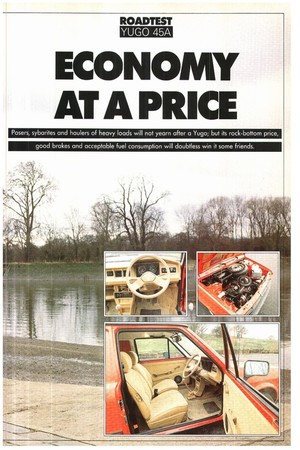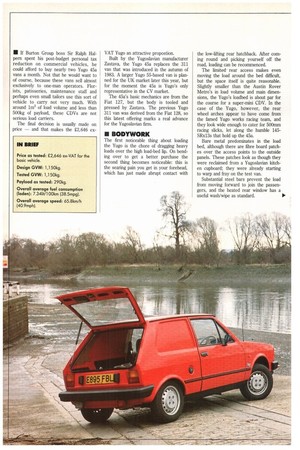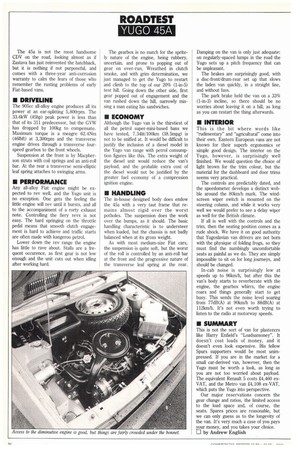ECONOMY AT A PRICE
Page 65

Page 64

Page 66

If you've noticed an error in this article please click here to report it so we can fix it.
Posers, sybarites and haulers of heavy loads will not yearn after a Yugo; but its rock-bottom price,
good brakes and acceptable fuel consumption will doubtless win it some friends.
• If Burton Group boss Sir Ralph Halpern spent his post-budget personal tax reduction on commercial vehicles, he could afford to buy nearly two Yugo 45a vans a month. Not that he would want to of course, because these vans sell almost exclusively to one-man operators. Florists, patisseries, maintenance staff and perhaps even small tailors use this sort of vehicle to carry not very much. With around 1ini of load volume and less than 500kg of payload, these CDVs are not serious load carriers.
The final decision is usually made on price — and that makes the £2,646 ex VAT Yugo an attractive propostion.
Built by the Yugoslavian manufacturer Zastava, the Yugo 45a replaces the 311 van that was introduced in the autumn of 1983. A larger Yugo 55-based van is planned for the UK market. later this year, but for the moment the 45a is Yugo's only representative in the CV market.
The 45a's basic mechanics are from the Fiat 127, but the body is tooled and pressed by Zastava. The previous Yugo 311 van was derived from the Fiat 128, so this latest offering marks a real advance for the Yugoslavian fun.
• BODYWORK
The first noticeable thing about loading the Yugo is the chore of dragging heavy loads over the high load-bed lip. On bending over to get a better purchase the second thing becomes noticeable: this is the searing pain you get in your forehead, which has just made abrupt contact with the low-lifting rear hatchback. After coming round and picking yourself off the road, loading can be recommenced.
The limited rear access makes even moving the load around the bed difficult, but the space itself is quite reasonable. Slightly smaller than the Austin Rover Metro's in load volume and main dimensions, the Yugo's loadbed is about par for the course for a super-mini CDV. In the case of the Yugo, however, the rear wheel arches appear to have come from the famed Yugo works racing team, and they look wide enough to cater for 500mm racing slicks, let along the humble 145Sitx13s that hold up the 45a.
Bare metal predominates in the load bed, although there are fibre board patches over the access points to the outside panels. These patches look as though they were reclaimed from a Yugoslavian kitchen cupboard; they were already starting to warp and fray on the test van.
Substantial steel bars prevent the load from moving forward to join the passengers, and the heated rear window has a useful wash/wipe as standard. The 45a is not the most handsome CDV on the road, looking almost as if Zastava has just reinvented the hatchback, but it is nothing if not purposeful, and comes with a three-year anti-corrosion warranty to calm the fears of those who remember the rusting problems of early Fiat-based vans.
• DRIVELINE
The 905cc all-alloy engine produces all its power at an ear-splitting 5,800rpm. The 33.6kW (45hp) peak power is less than that of its 311 predecessor, but the GVVV has dropped by 100kg to compensate. Maximum torque is a meagre 62.4Nm (461bft) at 3,300rpm and the transverse engine drives through a transverse fourspeed gearbox to the front wheels.
Suspension at the front is by Macpherson struts with coil springs and an anti-roll bar. At the rear a transverse semi-elliptic Leaf spring attaches to swinging arms.
• PERFORMANCE
Any all-alloy Fiat engine might be expected to rev well, and the Yugo unit is no exception. One gets the feeling the little engine will rev until it bursts, and all to the accompaniment of a rorty exhaust note. Controlling the fiery revs is not easy. The hard springing on the throttle pedal means that smooth clutch engagement is hard to achieve and traffic starts are often made with kangeroo petrol.
Lower down the rev range the engine has little to rave about. Stalls are a frequent occurence, as first gear is not low enough and the unit cuts out when idling after working hard. The gearbox is no match for the spritely nature of the engine, being rubbery, uncertain, and prone to popping out of gear on over-run, Wreathed in clutch smoke, and with grim determination, we just managed to get the Yugo to restart and climb to the top of our 20% (1-in-5) test hill. Going down the other side, first gear popped out of engagement and the van rushed down the hill, narrowly missing a man eating his sandwiches.
• ECONOMY
Although the Yugo van is the thirstiest of all the petrol super-mini-based bans we have tested, 7.341it/100km (38.5mpg) is not to be sniffed at. It would be difficult to justify the inclusion of a diesel model in the Yugo van range with petrol consumption figures like this. The extra weight of the diesel unit would reduce the van's payload, and the probable extra cost of the diesel would not be justified by the greater fuel economy of a compression ignition engine.
• HANDLING
The in-house designed body does endow the 45a with a very taut frame that remains almost rigid over the worst potholes. The suspension does the work over the bumps, as it should. The basic handling characteristic is to understeer when loaded, but the chassis is not badly balanced when at its gross weight.
As with most medium-size Fiat cars, the suspension is quite soft, but the worst of the roll is controlled by an anti-roll bar at the front and the progressive nature of the transverse leaf spring at the rear. Damping on the van is only just adequate: on regularly-spaced lumps in the road the Yugo sets up a pitch frequency that can be unpleasant.
The brakes are surprisingly good, with a disc-front/drum-rear set up that slows the laden van quickly, in a straight line, and without fuss.
The park brake held the van on a 33% (1-in-3) incline, so there should be no worries about leaving it on a hill, as long as you can restart the thing afterwards.
• INFERIOR
This is the bit where words like "rudimentary" and "agricultural" come into their own. Eastern European vans are not known for their superb ergonomics or simple good design. The interior on the Yugo, however, is surprisingly well finished. We would question the choice of light brown for the trim colour, but the material for the dashboard and door trims seems very practical.
The controls are predictably dated, and the speedometer develops a distinct wobble around the 80km/h mark. The windscreen wiper switch is mounted on the steering column, and while it works very well we would prefer to see a delay wiper as well for the British climate.
If all is well with the controls and the trim, then the seating position comes as a rude shock. We have it on good authority that Yugoslavian van drivers are not born• with the physique of folding frogs, so they must find the numbingly uncomfortable seats as painful as we do. They are simply impossible to sit on for long journeys, and should be changed.
In-cab noise is surprisingly low at speeds up to 961cm/h, but after this the van's body starts to reverberate with the engine, the gearbox whirrs, the engine roars and things generally start to get busy. This sends the noise level soaring from 77dB(A) at 90krn/h to 88dB(A) at 112Iun/h. It's not even worth trying to listen to the radio at motorway speeds.
• SUMMARY
This is not the sort of van for plasterers like Harry Enfield's "Loadsamoney". It doesn't cost loads of money, and it doesn't even look expensive. His fellow Spurs supporters would be most unimpressed. If you are in the market for a small car-derived van, however, then the Yugo must be worth a look, as long as you are not too worried about payload. The equivalent Renault 5 costs £4,460 exVAT, and the Metro van £4,108 ex-VAT, which puts the Yugo into perspective.
Our major reservations concern the gear change and ratios, the limited access to the load space and, of course, the seats. Spares prices are reasonable, but we can only guess as to the longevity of the van. It's very much a case of you pays our money, and you takes your choice.
IL by Andrew English
















































































































